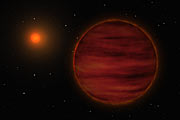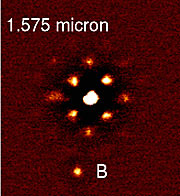Pressmeddelande
The Sun's New Exotic Neighbour
Very Cool Brown Dwarf Discovered Around Star in the Solar Neighbourhood
22 mars 2006
Using ESO's Very Large Telescope in Chile, an international team of researchers [1] discovered a brown dwarf belonging to the 24th closest stellar system to the Sun. Brown dwarfs are intermediate objects that are neither stars nor planets. This object is the third closest brown dwarf to the Earth yet discovered, and one of the coolest, having a temperature of about 750 degrees Celsius. It orbits a very small star at about 4.5 times the mean distance between the Earth and the Sun. Its mass is estimated to be somewhere between 9 and 65 times the mass of Jupiter.
At a time when astronomers are peering into the most distant Universe, looking at objects as far as 13 billion light-years away, one may think that our close neighbourhood would be very well known. Not so. Astronomers still find new star-like objects in our immediate vicinity. Using ESO's VLT, they just discovered a brown dwarf companion to the red star SCR 1845-6357, the 36th closest star to the Sun.
"This newly found brown dwarf is a valuable object because its distance is well known, allowing us to determine with precision its intrinsic brightness", said team member Markus Kasper (ESO). "Moreover, from its orbital motion, we should be able in a few years to estimate its mass. These properties are vital for understanding the nature of brown dwarfs."
To discover this brown dwarf, the team used the high-contrast adaptive optics NACO Simultaneous Differential Imager (SDI [2]) on ESO's Very Large Telescope, an instrument specifically developed to search for extrasolar planets. The SDI camera enhances the ability of the VLT and its adaptive optics system to detect faint companions that would normally be lost in the glare of the primary star. In particular, the SDI camera provides additional, often very useful spectral information which can be used to determine a rough temperature for the object without follow-up observations.
Located 12.7 light-years away from us, the newly found object is nevertheless not the closest brown dwarf. This honour goes indeed to the two brown dwarfs surrounding the star Epsilon Indi, located 11.8 light years away.
Howver, this newly discovered brown dwarf is unique in many aspects. "Besides being extremely close to Earth, this object is a T dwarf - a very cool brown dwarf - and the only such object found as a companion to a low-mass star," said Beth Biller, a graduate student at the University of Arizona and lead author of the paper reporting the discovery. "It is also likely the brightest known object of its temperature because it is so close."
The discovery of this brown dwarf hints that, at least close to the Sun, cool brown dwarfs prefer to be part of a couple with a star or another brown dwarf, rather than wandering alone in the cosmic emptiness. Indeed, of the seven cool brown dwarfs that reside within 20 light years of the Sun, five have a companion.
"This has wide-ranging implications for theories of brown dwarf formation, which, until now, tend to favour the production of single brown dwarfs," said team member Laird Close (University of Arizona).
Images of SCR 1845-6357 A and B in different filters (NACO-SDI/VLT)
High resolution images and their captions are available on this page.
Noter
[1] The team is composed of Beth Biller and Laird Close (Steward Observatory, University of Arizona, Tucson, USA), Markus Kasper (ESO, Garching, Germany), Wolfgang Brandner (Max-Planck Institute for Astronomy, Heidelberg, Germany), and Stephan Kellner (W.M. Keck Observatory, Waimea, Hawaii, USA).
[2] The NACO SDI camera is a unique type of camera using adaptive optics, which removes the blurring effects of Earth's atmosphere to produce extremely sharp images. SDI splits light from a single star into four identical images and then passes the resulting beams through three slightly different (methane-sensitive) filters. Only cool low-mass objects will have methane in their atmospheres and so only these objects will change brightness in the SDI filters. When the filtered light beams hit the camera's detector array, astronomers can subtract the images so the bright star disappears, revealing a fainter, cooler object otherwise hidden in the star's scattered light halo ("glare"). The SDI camera was developed and deployed by Laird Close (Steward Observatory, University of Arizona) and Rainer Lenzen (Max-Planck-Institute for Astronomy in Heidelberg) in collaboration with ESO.
Mer information
The work presented here will appear as a Letter to the Editor in the Astrophysical Journal ("Discovery of a Very Nearby Brown Dwarf to the Sun: A Methane Rich Brown Dwarf Companion to the Low Mass Star SCR 1845-6357", by B. Biller et al.).
Kontakter
Markus Kasper
ESO
Garching, Germany
Tel: +49 89 3200 6359
E-post: mkasper@eso.org
Beth Biller
University of Arizona
Arizona, USA
Tel: +1 520 621 2589
E-post: bbiller@as.arizona.edu
Laird Close
University of Arizona
Arizona, USA
Tel: +1 520 626 5992
E-post: lclose@as.arizona.edu
Om pressmeddelandet
| Pressmeddelande nr: | eso0611 |
| Legacy ID: | PR 11/06 |
| Namn: | SCR 1845-6357, SCR 1845-6357 A, SCR 1845-6357 B |
| Typ: | Milky Way : Star : Type : Brown Dwarf Milky Way : Star : Grouping : Binary |
| Facility: | Very Large Telescope |
| Instruments: | NACO |
| Science data: | 2006ApJ...641L.141B |
Our use of Cookies
We use cookies that are essential for accessing our websites and using our services. We also use cookies to analyse, measure and improve our websites’ performance, to enable content sharing via social media and to display media content hosted on third-party platforms.
ESO Cookies Policy
The European Organisation for Astronomical Research in the Southern Hemisphere (ESO) is the pre-eminent intergovernmental science and technology organisation in astronomy. It carries out an ambitious programme focused on the design, construction and operation of powerful ground-based observing facilities for astronomy.
This Cookies Policy is intended to provide clarity by outlining the cookies used on the ESO public websites, their functions, the options you have for controlling them, and the ways you can contact us for additional details.
What are cookies?
Cookies are small pieces of data stored on your device by websites you visit. They serve various purposes, such as remembering login credentials and preferences and enhance your browsing experience.
Categories of cookies we use
Essential cookies (always active): These cookies are strictly necessary for the proper functioning of our website. Without these cookies, the website cannot operate correctly, and certain services, such as logging in or accessing secure areas, may not be available; because they are essential for the website’s operation, they cannot be disabled.
Functional Cookies: These cookies enhance your browsing experience by enabling additional features and personalization, such as remembering your preferences and settings. While not strictly necessary for the website to function, they improve usability and convenience; these cookies are only placed if you provide your consent.
Analytics cookies: These cookies collect information about how visitors interact with our website, such as which pages are visited most often and how users navigate the site. This data helps us improve website performance, optimize content, and enhance the user experience; these cookies are only placed if you provide your consent. We use the following analytics cookies.
Matomo Cookies:
This website uses Matomo (formerly Piwik), an open source software which enables the statistical analysis of website visits. Matomo uses cookies (text files) which are saved on your computer and which allow us to analyze how you use our website. The website user information generated by the cookies will only be saved on the servers of our IT Department. We use this information to analyze www.eso.org visits and to prepare reports on website activities. These data will not be disclosed to third parties.
On behalf of ESO, Matomo will use this information for the purpose of evaluating your use of the website, compiling reports on website activity and providing other services relating to website activity and internet usage.
Matomo cookies settings:
Additional Third-party cookies on ESO websites: some of our pages display content from external providers, e.g. YouTube.
Such third-party services are outside of ESO control and may, at any time, change their terms of service, use of cookies, etc.
YouTube: Some videos on the ESO website are embedded from ESO’s official YouTube channel. We have enabled YouTube’s privacy-enhanced mode, meaning that no cookies are set unless the user actively clicks on the video to play it. Additionally, in this mode, YouTube does not store any personally identifiable cookie data for embedded video playbacks. For more details, please refer to YouTube’s embedding videos information page.
Cookies can also be classified based on the following elements.
Regarding the domain, there are:
- First-party cookies, set by the website you are currently visiting. They are stored by the same domain that you are browsing and are used to enhance your experience on that site;
- Third-party cookies, set by a domain other than the one you are currently visiting.
As for their duration, cookies can be:
- Browser-session cookies, which are deleted when the user closes the browser;
- Stored cookies, which stay on the user's device for a predetermined period of time.
How to manage cookies
Cookie settings: You can modify your cookie choices for the ESO webpages at any time by clicking on the link Cookie settings at the bottom of any page.
In your browser: If you wish to delete cookies or instruct your browser to delete or block cookies by default, please visit the help pages of your browser:
Please be aware that if you delete or decline cookies, certain functionalities of our website may be not be available and your browsing experience may be affected.
You can set most browsers to prevent any cookies being placed on your device, but you may then have to manually adjust some preferences every time you visit a site/page. And some services and functionalities may not work properly at all (e.g. profile logging-in, shop check out).
Updates to the ESO Cookies Policy
The ESO Cookies Policy may be subject to future updates, which will be made available on this page.
Additional information
For any queries related to cookies, please contact: pdprATesoDOTorg.
As ESO public webpages are managed by our Department of Communication, your questions will be dealt with the support of the said Department.




